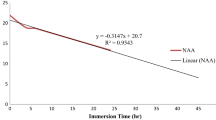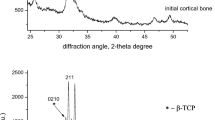Summary
The rate of calcium extraction with EDTA (ethylenediamine tetraacetic acid) from thin bone slices (300 μm-2mm thick) was determined by aid of an atomic absorption spectrophotometer. A 0.5 mm thick bone slice was completely decalcified with 15% (0.40 M), 8% (0.22 M), and 4% (0.11 M) EDTA in 24 h, 3 days, and 5 days, respectively (vol. 15 ml, temp. 4° C, pH 7.4). At 37 and 60° C the speed of demineralization was slightly increased as compared with that at 20° C, while no difference was observed between 4 and 20° C. Bone slices with a thickness of 0.3, 0.5, 1 and 2 mm were decalcified-in the same order-in 24 h, 2, 3, and 5 days (8% EDTA, 4° C, pH 7.4). At pH 7.4, the decalcification rate was a little slower than at pH 5.0 and 8.5. Agitation did not affect the decalcifying velocity, nor did the volume of the agent, except when the volume was very small. The demineralization of ordinary bone, containing both compact and spongy bone, was found to be more rapid than that of homogeneous bone reported earlier. The acidic buffers and New Decalc®, which served as reference substances, exerted a more vigorous decalcifying effect than EDTA. K formate/formic acid buffer, pH 3.15, demineralized a 1 mm thick bone slice in 24 h, and 2 days was needed with Na lactate/lactic acid buffer, pH 3.70. With New Decalc®, pH 0.9, the corresponding demineralization was accomplished in 1.5 h. Atomic absorption spectrophotometer proved to be a useful tool in the evaluation of calcium extraction velocity from bone slices.
Similar content being viewed by others
References
Baird IL, Winborn WB, Bockman DE (1967) A technique of decalcification suited to electron microscopy of tissues closely associated with bone. Anat Rec 159:281–290
Bélanger LF, Bélanger C, Semba T (1967) Technical approaches leading to the concept of osteocytic octeolysis. Clin Orthop Relat Res 54:187–196
Bélanger LF, Copp DH, Morton MA (1965) Demineralization with EDTA by constant replacement. Anat Rec 153:41–48
Birkedal-Hansen H (1974) Kinetics of acid demineralization in histologic technique. J Histochem Cytochem 22:434–441
Bonucci E, Reurink J (1978) The fine structure of decalcified cartilage and bone: a comparison between decalcification procedures performed before and after embedding. Calcif Tissue Res 25:179–190
Brain EB (1966) The preparation of decalcified sections. Charles C. Thomas, Springfield, IL, USA pp 54–132
Charman J, Reid L (1972) The effect of decalcifying fluids on the staining of epithelial mucins by alcian blue. Stain Technol 47:173–178
Clark PG (1954) A comparison of decalcifying methods. Am J Clin Pathol 24:1113–1116
Dallemagne MJ, Richelle LJ (1973) Inorganic chemistry of bone. In: Zipkin I (ed) Biological mineralization, John Wiley, New York London, pp 23–42
Eggert FM, Germain JP (1979) Rapid demineralization in acidic buffers. Histochemistry 59:215–224
Ericsson JLE, Göthlin G (1971) Preparation of calcified tissue for fine structural demonstration of acid phosphatase. J Ultrastruct Res 38:195
Fejerskov O (1971) The effect of different demineralizing agents on oral mucous membrane. Scand J Dent Res 79:172–182
Goldstein A, Aronson L, Kalman SM (1974) Binding forms in the drug-receptor interaction. In: Goldstein A, Aronson L, Kalman SM (eds) Principles of drug action: the basis of pharmacology. Wiley & Sons, New York London, pp 11–12
Humason GL (1967) Decalcification. In: Humason GL (ed) Animal tissue techniques, W. H. Freeman San Francisco London, pp 27–32
Hunter HA, Nikiforuk G (1954) Staining reactions following demineralization of hard tissues by chelating and other decalcifying agents. J Dent Res 33:136–138
Martino L, Yeager VL, Taylor JJ (1979) An ultrastructural study of the role of calcification nodules in the mineralization of woven bone. Calcif Tissue Res 27:57–64
Mellor DP (1979) Chemistry of chelation and chelating agents. In: Levine WG (ed) The chelation of heavy metals. Pergamon Press, Oxford New York
Morse A (1945) Formic acid-sodium citrate decalcification and butyl alcohol dehydration of teeth and bones for sectioning in paraffin. J Dent Res 24:143–153
Nikiforuk G, Sreebny L (1953) Demineralization of hard tissues by organic chelating agents at neutral pH. J Dent Res 32:859–867
Page KM (1977) Bone and the preparation of bone sections. In: Bancroft JD, Stevens A (eds) Theory and practice of histological techniques. Churchill Livingstone, London New York, pp 223–248
Vaughan JM (1970) Chemistry of bone mineral. In: Vaughan JM (ed) The physiology of bone. Oxford University Press, Oxford, pp 91–99
Verdenius HHW, Alma L (1958) A quantitative study of decalcification methods in histology. J Clin Pathol 11:229–236
Warshawsky H, Moore G (1965) A method of fixation and decalcification of rat incisors for electron microscopy. Anat Rec 151:431
Author information
Authors and Affiliations
Rights and permissions
About this article
Cite this article
Kiviranta, I., Tammi, M., Lappalainen, R. et al. The rate of calcium extraction during EDTA decalcification from thin bone slices as assessed with atomic absorption spectrophotometry. Histochemistry 68, 119–127 (1980). https://doi.org/10.1007/BF00489507
Received:
Issue Date:
DOI: https://doi.org/10.1007/BF00489507




